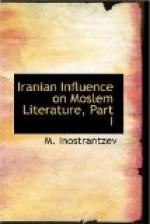APPENDIX I
INDEPENDENT ZOROASTRIAN PRINCES OF TABARISTAN.
In the mountains to the south of the Caspian Sea the Persians defended themselves longer than in the rest of the Empire against the Arab invasion. Here the Arsacide princes had permitted the local tribes to rule, for these tribes were probably from the first almost independent and only acknowledged their paramountcy and paid tribute. They had the title of Spadhapati or in modern language Ispehbed which was turned into the Arabic Isfehbed. One of them, Gushnasp Shah, is named as a contemporary of Ardashir I. It was only so late as in the time of Kawadh that this king succeeded in establishing a Sasanian prince, his son Keyus, as Shah of Tabaristan in 530. At the death of his father he contested the throne with Khusrow I, and was therefore slain by the latter in 537. His son Shapur remained in Persia, and a prince of the Arsacide house of Qaren, named Zarmihr, son of Sokhra was appointed governor. The administration of Rae, Derbend and a portion of Armenia was before now entrusted to Jamasp, a son of Peroz, who was succeeded by his son Narsi, while another son, Behvat, father of Surkhab became the ancestor of the kings of Shirvan who were known as Shirvan Shahs. Narsi’s son was Peroz, the father of Farrukhan Gilanshah, whose capital accordingly was Gilan and who in 643 concluded a peace with the Arabs.
Gil Gaubareh, the son of this prince, united, with the consent of Yezgird the III, who could not prevent him, Gilan with Tabaristan, where the dynasty of Zarmihr had come to an end. It cannot be doubted that Sasanian princes became the governors of these territories. The sons of Gaubareh were Daboe (660-676) and Patospan, in Pahlavi Patkospan or governor, in modern Persian Baduspan. Daboe was succeeded by his brother Khurshed (676-709). We possess coins struck by him in the years 706-709. Then came Daboe’s son Ferkhan more correctly Farrukhan, the Great (709-722); he defeated several attempts on the part of the Moslems to penetrate the country. Our authorities are Tabari (vol. 2 p. 1321); Kitaboloyun (22-8); Zahireddin (45, 10.273, 14); Mordtmann (ZDMG 19, 494). His son Dad-Burzmihr died according to Zahireddin in 748, still his son Khurshed II already struck in 734 his first coin. He was defeated by the Arabs and took poison which he used to carry in his signet ring in 759.
The Masmoghan or the “priest-prince,” the successor of Zarathustrotema of Ragha or modern Rai, who had his seat in the city of Demawend or the Castle of Ustunavend, and who was the son-in-law of the Ispehbed, was defeated and the daughters of both the princes were married to members of the house of Abbas.
The descendants of the Badusepan, whom Zahireddin carefully traces in all the branches of the family, ruled over Ruyan, Rustamdar, Nur and Kujur, down to the year 1453, when they divided themselves into two branches which continued to reign till 1567, and 1576.




